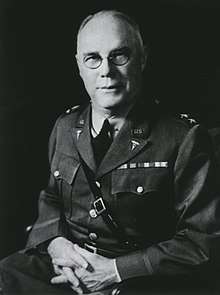James C. Magee
| Jame Carre Magee | |
|---|---|
 | |
| Born |
January 23, 1883 Ireland |
| Died |
October 15, 1975 (age 92) Washington D.C |
| Allegiance | United State of America |
| Service/ | Army |
| Rank | Major General |
| Awards | Distinguished Service Medal, Purple Heart, World War I Victory Medal |
| Spouse(s) | Irene MacKay Magee |
James Carre Magee (January 23, 1883 - October 15, 1975) was an American medical officer and later Surgeon General of the United States Army from 1939 - 1943.
Personal life
James Magee was born on January 23, 1883 in County Donegal, Ireland to Edward Carre Magee and Elizabeth Armstrong Magee. He was the fourth son of a Pennsylvania businessman who were working in Ireland. The Magees returned to Pennsylvania where James Magee spent his youth. He attended Jefferson Medical College in Philadelphia, and received his M.D. in 1905.[1]
During World war I, Magee achieved the rank of captain and chief surgeon.[2]
Death
He died at age 92 at Walter Reed General Hospital and was buried at Arlington National Cemetery.
Surgeon general

On June 1, he was appointed by President Roosevelt to replace Major General Charles R. Reynolds as Surgeon General of the United States Army.[3] The outbreak of World War II in Europe in September 1939 and the declaration of a limited national emergency by President Franklin D. Roosevelt that month confronted the new Surgeon General with enormous difficulties as the Army slowly began preparing for war. Magee had to confront the huge problems in preparing the Army Medical Department for its wartime expansion.[1]
General Magee's tenure was marked by both successes and criticism. Magee was not a favorite of Army Chief of Staff, General George Marshall and Lieutenant General Brehon B. Somervell, commander of the Services of Supply. This eventually resulted in a major investigation by the War Department's Wadhams Committee from August through November 1942. The committee's final report was issued in November 1942 and outlined recommendations to improve the efficiency of the Army Medical Services. Many of the recommendations were never implemented until early in 1943. Magee's adversaries may have encouraged the Wadhams Committee investigation of the Medical Department in an attempt to remove him from his position but failed.[1]
George Marshal was able to convince president Franklin D. Roosevelt to not reappoint him to the position after his four-year term as surgeon general was over. He retired from the position on May 31, 1943.[4]
References
- 1 2 3 "A CONCISE BIOGRAPHY OF MAJOR GENERAL JAMES CARRE MAGEE". history.amedd.army.mil. Retrieved 2017-09-21.
- ↑ "GEN.JAMES C.MAGEE, LED ARMY SURGEONS". Retrieved 2018-07-16.
- ↑ Ewing, Harris. "New Surgeon General. Washington, D.C., May 8". The Library of Congress. Retrieved 2017-09-21.
- ↑ Hedley-Whyte, John; Milamed, Debra R. (May 2013). "Our Blood Your Money". The Ulster Medical Journal. 82 (2): 114–120. ISSN 0041-6193. PMC 3756870. PMID 24082291.